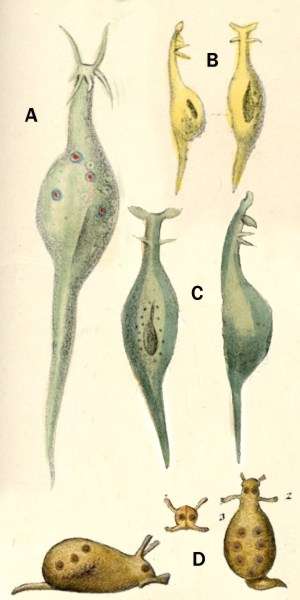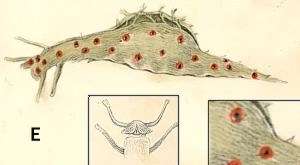

Stylocheilus longicauda & Stylocheilus citrina
Nomenclatural discussion
Order: ANASPIDEA
Superfamily: APLYSIOIDEA
Family: Aplysiidae
PHOTO
A. Aplysia longicauda Quoy & Gaimard, 1825 - original illustration. "..Green with red spots circled with blue, and other spots of white and blue. On floating Fucus off New Guinea" [translation]
B. Aplysia (Notarchus) citrina Rang, 1828 - original illustration. ".. Yellow with white spots. In equatorial mid-Atlantic on floating Fucus" [translation]
C. Aplysia nudata Rang, 1828 - original illustration. ".. Green with some pale spots. On floating Fucus .. Hawaiian waters" [translation]
D.Aplysia ocellata Ferussac in Rang 1828. [This is a photo from the Leiden Museum of van Hasselt's painting from Indonesia on which Ferussac based his species. - Yellow with blue spots with yellow ring].
E. Aplysia striata Quoy & Gaimard, 1832 - original illustration.
This problem concerns two species of Stylocheilus described by Quoy & Gaimard. The first, Stylocheilus longicauda, in 1825 (PHOTO A) and the second, Stylocheilus striatus in 1832 (PHOTO E). Unfortunately Quoy & Gaimard noted that S. striatus was probably the same as S. longicauda so beginning a confusion which has persisted until the present. Most workers consider that there are two species of Stylocheilus, one with dark longitudinal lines, a mottled colour pattern, and compound papillae, and the second with a uniform yellow or green colour, simple papillae, no lines, and an extremely long slender 'tail'. I have presented many of the original descriptions and illustrations here to show that Quoy & Gaimard's two species are not synonymous and represent the earliest names for each species.
In recent years the yellow species of Stylocheilus has been identified as Stylocheilus citrina (Rang, 1828) (Marcus, E. & Marcus, E., 1962; Marcus, E., 1972). It has a circumtropical distribution and has usually been found floating in the open ocean on drifting brown algae. On two occasions I found numbers of animals washed ashore in Tanzania, on drift algae. The body ranges in colour from bright yellow to bright green with scattered ocellate spots. In specimens I have examined, the spots are usually blue, often with a reddish edge. Surrounding the spot is a clear ring then a ring of orange. In some specimens the red edge dominates and the blue spots appear red. White and blue spots without a surrounding ring can also occur. There a scattered short papillae over the body. The body is very elongate and its most characteristic feature is the extremely prolonged narrow 'tail' which can make up to half the body's total length. The sole produces a very sticky mucus. This elongation of the posterior foot, and the sticky mucus, are probably an adaptation to life on floating weed.
It seems there is an important nomenclatural problem surrounding this species. Although the name Stylocheilus citrina (Rang), refers to it, the earliest name for it must surely be Stylocheilus longicauda (Quoy & Gaimard, 1825), which is at present used incorrectly for the common species with dark longitudinal lines down the body and a relatively short 'tail'. Quoy & Gaimard's description of Stylocheilus longicauda is of a 'pleasing' green coloured animal with spots of varied red and blue and an extremely long narrow tail, found on floating Fucus in New Guinea waters.
On the right I have reproduced the original figures of most of the early Stylocheilus names. The confusion seems to have arisen from a comment by Quoy & Gaimard (1832) in their description of Stylocheilus striatus where they suggest it may be the same as Stylocheilus longicauda. Stylocheilus striatus would seem to be the earliest name for the lined form which has usually been called Stylocheilus longicauda.
Apart from the dark lines on the mantle, the two species differ externally in body shape and background colour. Stylocheilus striatus has a much shorter 'tail', usually less than a third the total body length while in Stylocheilus longicauda, as its name inplies, the 'tail' is up to half the total body length. Stylocheilus striatus has a translucent body with patches of greens, browns and white, and often with many branched papillae. The background colour of Stylocheilus longicauda, on the other hand, is a uniform yellow or green, and papillae are sparse and seldom branched. Ecologically they are quite different, Stylocheilus longicauda having a circumtropical distribution as a pelagic animal drifting on floating algae and other floating objects, while Stylocheilus striatus is a circum-tropical shallow water bottom-dweller.
Two other names, Aplysia (Phycophila) euchlora A. Adams, 1861 [green…tail produced ..on floating Zostera - Japan] and Tethys (Phycophila) adamsi Pilsbry, 1896 [.. very long tail] also refer to Stylocheilus longicauda. A.Adams (1861) proposed the genus Phycophila for these two 'species', which he characterised by its long and narrow tail adapted for clinging to floating weed far from shore.
Relevant Stylocheilus references.
Go to Stylocheilus longicauda Page.
Go to Stylocheilus striatus Page.
Rudman, W.B., 1999 (August 3) Stylocheilus longicauda & Stylocheilus citrina Nomenclatural discussion. [In] Sea Slug Forum. Australian Museum, Sydney. Available from http://www.seaslugforum.net/factsheet/stylnome
Related messages
-
Stylocheilus's name - beating a dead horse?
From: Edwin Cruz-Rivera, March 16, 2001 -
Stylocheilus nomenclature
From: Ángel Valdés, June 11, 2000 -
Stylocheilus nomenclature
From: Richard Willan, June 6, 2000 -
The true identity of Stylocheilus longicauda
From: Bill Rudman, August 5, 1999
